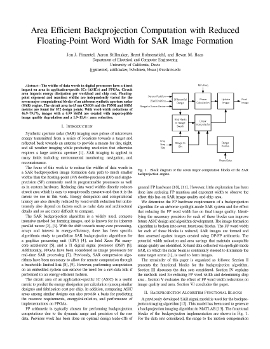Area Efficient Backprojection Computation with Reduced Floating-Point Word Width for SAR Image Formation
Jon J. Pimentel
Aaron Stillmaker
Brent Bohnenstiehl
Bevan M. Baas
VLSI Computation Laboratory
Department of Electrical and Computer Engineering
University of California, Davis
Abstract:
The widths of data words in digital processors have a direct
impact on area in application-specific ICs (ASICs) and FPGAs. Circuit
area impacts energy dissipation per workload and chip cost. Floatingpoint
exponent and mantissa widths are independently varied for the
seven major computational blocks of an airborne synthetic aperture radar
(SAR) engine. The circuit area in 65 nm CMOS and the PSNR and SSIM
metrics are found for 572 design points. With word-width reductions of
46.9–79.7%, images with a 0.99 SSIM are created with imperceptible
image quality degradation and a 1.9–11.4x area reduction.
Paper
Reference
Jon J. Pimentel, Aaron Stillmaker, Brent Bohnenstiehl and Bevan M. Baas,
"Area Efficient Backprojection Computation with Reduced Floating-Point Word Width for SAR Image Formation,"
IEEE Asilomar Conference on Signals, Systems and Computers (ACSSC)
Nov. 2015.
BibTeX Entry
@INPROCEEDINGS{Pimentel:ACSSC2015,
author = {Jon J. Pimentel, Aaron Stillmaker, Brent Bohnenstiehl and Bevan M. Baas},
booktitle = {IEEE Asilomar Conference on Signals, Systems and Computers ({ACSSC})},
title = {Area Efficient Backprojection Computation with Reduced Floating-Point Word Width for SAR Image Formation},
year = 2015,
month = nov
}
VCL Lab
| ECE Dept.
| UC Davis
Last update: December 8, 2014
 PDF (3.0 MB),
(c) Copyright, 2015, IEEE
PDF (3.0 MB),
(c) Copyright, 2015, IEEE PDF (3.0 MB),
(c) Copyright, 2015, IEEE
PDF (3.0 MB),
(c) Copyright, 2015, IEEE